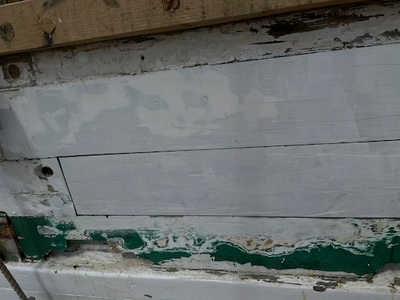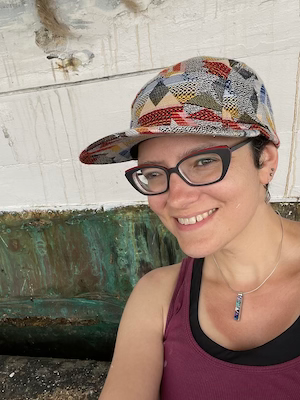Spring on the Starboard Side
- Brooke Lanier

- May 31, 2022
- 3 min read
Updated: Feb 13
I started volunteering aboard the Barkentine Gazela in March of 2022 after a year of making paintings of her port side as viewed from, well, the port at Penn's Landing in Philadelphia. I take hundreds of photos as a way of reminding me of everything I've ever found interesting, so in going through my phone I realized I had inadvertently created a partial record of the ship repairs we've done this spring.

In this photo from May 26, 2022, you can see how badly peeled the paint is on the starboard bow (right side of the photo) and how there are a couple rotten boards that need replacing. Towards the center of the photo, you can see how there are new boards in various states of repainting and with some of the seams caulked.
The first 3 photos are of the first time I climbed over the starboard side in March. Marcus showed me how they were removing rotten boards from the hull and bulwarks to replace them. I have since learned that the hull is the part of the boat that keeps the water out, and the bulwarks is the railing that keeps the sailors in. I wrote a previous post about the process of replacing planks. The 4th photo above shows the new boards in the bulwarks and some older ones in various stages of scraping, sanding, and re-painting. Look at all the cracks. That's a problem!

The old-school way to caulk cracks is to stuff them with oakum and then cover the oakum with waterproof material, such as tar. What is oakum? It is kind of a fluffier version of rope, more loosely packed than yarn, made of long fibers of jute or hemp. You have to align the fibers so that they're all going in the same direction, then pull them so that the strand is of uniform with, then roll it once or twice gently on your lap so that it bonds to itself but doesn't get compacted enough to become like dreadlocks or yarn. Oh. And if you don't do it right, the thing will not be able to hold its own weight and will fall apart when you try to lift up an end and insert it into the crack you need to fill. It is a skill that not everyone is able to acquire and I was told that maybe I didn't want people to find out I was capable of doing this potentially infuriating task. I forgot to take pictures of the oakum I made, but I produced several usable fathoms, and also I learned that a fathom is six feet.

Henry and Io were standing on the floating dock caulking the hull with oakum part of the time while I was above them on the scaffold. The scene looked like a painting inspired by Kant's musings on the sublime and the beautiful, so I had to take a photo.

Since I was caulking the bulwarks (which is above water unless something goes horribly wrong), I got to use the kind of caulk that people are more familiar with finding in their bathrooms and kitchens. (See also, Ben Franklin Bridge in the background.)

After Io and Henry caulked the hull with oakum, they painted over it with oil-based paint. You can see the little fluffy tails of oakum sticking out so they could keep track of where they stopped. Above the green line is the bulwarks, and you can see where I had and had not sealed at that point.

I kneeled on this scaffolding affixed to the ship for about 5 hours, but I got the first pass done. Some of the cracks were quite large and will require a second go-round. I'm always anxious about doing a good job because if I don't, the ship will rot or some component may not function properly. People could say,"That section's all rotten. Oh. That's because in 2022 Brooke Lanier was sloppy with her caulk." It's important to me to be conscientious about helping preserve the ship so that everyone else can enjoy it.
When I finished my task, I climbed down under the scaffolding and just sat there for about half an hour studying the copper plating on the hull. I was looking for the order in which the layers of oxidation occurred, how the drips reacted to the protrusions and dents in the metal, and how the colors were layered and scraped away. Then, I went to my studio and tried to translate that into paint.
Thursday, June 9th from 4-6 pm I will be giving a walking tour through the Independence Seaport Museum and talking about how the historic ships of Penn's Landing inspire my artwork. We will meet at the ISM and walk past the Gazela, Becuna, Olympia, and Moshulu, ending up at my studio a mile from the museum. You can register here. I hope you'll join us!



















Comments